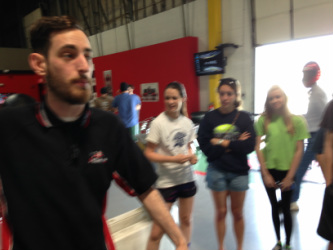|
Roots Student Ministries has a crazy month ahead, full of opportunities for our students to serve! June starts out with the KIUMC Family Carnival, June 5-8. Our mission teams are running the Holy Smoke Pulled Pork booth, as a fundraiser for our upcoming trips. All students are welcome to help out, either with the pulled pork or by running a game at the Carnival. KIUMC provides free games for families attending the Carnival!
Our high school mission trip to Boston embarks on June 15 and will return on June 21. They will be serving the cities of Lynn and Boston, MA in a variety of ways, including running a VBS, working in a homeless shelter, and serving in a soup kitchen. Our middle school trip to Harrisburg is June 29 - July 3. The city of Harrisburg, PA is in desperate need of support after declaring bankruptcy in 2010. We hope to fill some gaps by helping impoverished citizens, holding a VBS, and visiting the elderly in nursing homes. Both of our mission trips are organized by YouthWorks, a stellar organization that oversees hundreds of youth group mission trips every Summer. In between those two trips is KIUMC's own VBS - SonTreasure Island, June 23-27! We are in need of enthusiastic youth volunteers to step up and show some little kids who Jesus is! If you or your child are interested in helping out, please contact Ted Northrop or Cheri Sweet. Keep checking back to hear about the events we have planned for July. We'll have a few low-key events and outings, perfect to just hang out and invite some friends! This is a resource provided by Orange, whose curriculum we use for teaching. Parents, read this!
1. We’re Teaching this. Branding- it’s everywhere. You can’t turn on the TV or drive down the street without seeing hundreds of ads and billboards. Companies spend millions of dollars trying to shape how YOU see THEM, developing their brand. But what about the Church? What are WE known for? Philippians chapter 2, has a lot to say about the way we love others. As we unpack this chapter, we discover that our love for people, both inside and outside the church, ultimately determines what we are known for—our brand. 2. Think About This From Losing Your Marbles / Playing for Keeps by Reggie Joiner, Kristen Ivy, Elizabeth Hansen I remember a few years ago when I was leading a small group and one of the girls had stopped attending. I knew she was making some unwise choices related to drinking, and she was choosing not to come to church anymore because she didn’t want to feel judged. But here’s the interesting thing: she still liked hanging out. We would meet from time to time, at Starbucks, at a school event,—anywhere that she knew we would have fun. And in those moments, I didn’t talk about her decisions. She knew what I thought. But I knew at that juncture in her life, it was more important to have fun and stay connected than to continue reminding her of something she already knew. Hint: most kids and teenagers shut down when you take the eye-to-eye, “let’s talk about what’s going on” approach, they tend to talk when they’re engaged in a fun activity, not making eye contact, and feel in control of the agenda. If you’re a parent, you may need to set aside time with your kids when you agree not to discuss their issues. This can be especially true if they are in a tough season of life. When the tension is high, you need a scheduled break—just to have fun together. It’s not that fun is the most important thing. If you give teenagers words and stories that are boring, they may not care. If you belong to a tribe that never laughs, they won’t want to be a part of it. So whatever you do this week, make it fun. 3. Try This When is the last time your family had fun without an agenda? No strings attached, fun? No lesson involved, fun? No obligations to the baseball team, work picnic, church activity or school involved, fun? Maybe it’s time for that. Ask your student for ideas on something that they think would be really fun to do as a family. Students tend to engage more when they have some input into which activity is chosen. Say something like this, “I think it’s time we do something fun as a family. How would you feel about planning it?” Some students really like to go to the mall. Others hate it. Some would love to play mini-golf with their family. Others would cringe at the idea. Allowing them to plan the event, offering some ownership, can help students have a positive attitude and prevent the dreaded eye-roll. As parents, sometimes the idea of a family event can be intimidating. “What if my teenager doesn’t want to be seen in public with me?” That’s the great thing about letting THEM choose. They may choose a big night out but or they may ask for a simple movie night in the house. Choose to have fun together no matter what you do! Simply spending time together as a family without fighting can go a long way in easing the tension between parents and teens. Make a commitment on your part to do the activity—no agenda, no complaining, and no lecturing. So give them a budget limit, if appropriate, and let them be as creative or as simple as they want Just have fun together. Remember, the goal is to let students know you not only love them, but you like them and what better way to communicate that than by hanging out with them and having fun? Get connected to a wider community of parents at www.orangeparents.org.  What an awesome Saturday! We took our high schoolers to Autobahn Motor Speedway in Jessup, MD. It was an early morning, but it was totally worth it. After registering, we were able to watch a few races in preparation for our event. One of the employees (who didn't seem to like getting his picture taken) talked us through how to drive the karts. Then... it was race time. Those karts were fast. Like 50 mph fast. And the acceleration threw you back in the seat. We had an awesome time racing, spinning each other out, and, at times, making like bumper cars. Here's a very short video of us on the track. We tried capturing more footage, but it didn't turn out very well. Thank you to everyone who came and made it a memorable day! We’re Teaching This:
When we hear the word entourage, most of us think of celebrities walking the streets of Beverly Hills, barking orders at their “people”—people that work for them or just get paid to hang out with them. By definition, an entourage is a group of people attending or surrounding an important person. Even if we don’t feel important, most of us want at least a handful of people who like to hang around us—people who laugh at our jokes, go to the movies with us, and simply have our back. King David, his son Absalom, and his grandson Rehoboam were no different. As royals, each had an entourage and through their experiences we see that the choices we make with those around us can change everything. Think About This: A quick internet search reveals the worries many parents feel when it comes to their teen’s friends. “How to spot a bully”. “How to spot a bad influence”. “How to spot the wrong crowd”. There is plenty to worry about when it comes to your child’s friends. But what if you have more influence than you think? What if you were able to not only help your teen choose friends, but to directly influence the life choices those friends make? More and more studies say you can. A study published in the archives of Pediatric and Adolescent Medicine suggests that teens with friends who have strict parents are less likely to binge drink and make other poor life choices. http://fowler.ucsd.edu/parental_influence_on_substance_use.pdf Think about that. The students in this study were most influenced by their friends’ parents, not just their friends. In fact, you probably don’t need a lot of research to know this. Have you ever heard someone say, “She is like a second mother to me”. Probably so. Many of us grew up with at least one set of friend’s parents who influenced us. Part of maturing is beginning to listen to multiple voices, multiple adult influences. As parents we have an incredible opportunity to speak into our own children’s lives by using our influence to guide their friends. Having influence on your child’s friends doesn’t mean you have to be the “cool one”. It doesn’t mean you have to host or allow parties, throw caution to the wind, and be their best buddy. It also doesn’t mean you have to legally adopt them or have them over every night of the week. Having influence can be as simple as taking one step toward including a friend in your normal family plans.
Everyone wants their teen to be wise and intentional when it comes to friends. And the best way to teach that skill is to model it. Think about the friends your teen already spends time around. How intentional are you about investing time in those people? Are you using your influence to help that person in any way? Is there one teen you could invite to dinner, to hang out, or to be helpful? Use the suggestions below to help you figure out how you can be intentional with your teen’s friends. 1. My teen spends the most time with.... 2. One friend I can pray for this week is... 3. One friend I can invite and invest in this month is... Social media is a vast world that inundates teenagers' lives. The primary place for socializing is no longer the playground or cafeteria - it's the smart phone. The Internet has been around for a while now, and many parents are aware of the dangers it can pose for children. Therefore, we put measures in place to protect the home computer. However, the computer has become a secondary utility to the smart phone. I hope this post can be an introduction for parents who aren't familiar with the various social media entities out there today. For this post, we'll discuss some of the more public social media services. We'll go through various services with a brief description and some tips on how to protect your children. Next week, we'll tackle some more private social media services such as Snapchat, Kik, Ask.fm, and of course, texting.  Instagram - www.instagram.com Instagram is easily the most popular social media among teenagers today. Users post pictures of various things in their lives - friends, food, music, etc. These posts are viewable to anyone who "follows" their account. Users can also "like" others' photos and submit comments. A lot of interaction happens in the comments. Your account can be set to public or private. If public, anyone can view your posts. If private, others must request your permission to view your posts. Most teenagers leave their account public because it can be a hassle to have to approve everyone who wants to follow you. You can also send direct messages - which are always private and viewable to only the recipient. Instagram is mainly mobile - meaning you must download the app to use most of the features. Once you've made an account in the app, you can access some features via www.instagram.com, but not much. Instagram offers it's own Privacy & Safety Center for parents to read and learn more about protecting their kids. Highly recommended for all parents of middle and high schoolers!  Twitter - www.twitter.com Twitter is the second most popular public social media service amongst teenagers. Users can post short texts - limited to 140 characters - or pictures called "tweets". This keeps everything brief and light. Users can "follow" other users in order to see their tweets regularly. Twitter is really popular for celebrities to communicate directly with their fans. Your teenager probably "follows" their favorite musicians, actors, and athletes. Just like Instagram, an account can be either public or private. Twitter can also add a location to your tweets. You can reply to other people's tweets by "tweeting at" their username. Twitter usernames begin with an @ symbol, followed by the name. Mine, for example, is @tednorthrop. There is no way to comment directly on someone else's tweet; you have to post a tweet of your own in response. There is also a direct messaging system, which allows users to communicate privately, unseen to the public. Usually called DMing (direct messaging), this is a popular way for teenagers to communicate. Twitter's website is fully functional with features, but most teenagers will only use the mobile app. Twitter also has a safety center, which I encourage all parents to read. Twitter is becoming less popular among teens, for two main reasons. First, it is being increasingly used for marketing. Corporations and organizations can have accounts that can be really aggressive in marketing. Secondly, it is becoming more popular for parents. The last thing any student wants is for their parents to follow them on Twitter. This drives them to other, more private, social media sites.  Facebook - www.facebook.com Facebook is most likely the most familiar social media site to parents who are reading this. A user can "friend" other users can see the things they post. Facebook features comments and likes. Other users can "like" your post and leave a comment of their own on what you posted. Facebook also has a direct messaging system, which is private to the public. You can also "like" pages of celebrities, businesses, and other groups. It is very common for a business to do most of their communication through Facebook. Facebook's popularity is continually decreasing among teenagers. Yep, you guessed it - it's because parents are all on Facebook now. Even if teenagers have a Facebook account, it is rarely used. If you have a Facebook and are friends with your child, that is not sufficient to keep an eye on their online behavior. Facebook boasts a slew of privacy features. A user can choose for their posts to be viewable to only a portion of their friends. That means a teenager could make a post viewable to everyone but their parents. You can read more about privacy on Facebook on their help page. |
Archives
July 2017
Categories |
Roots Student Ministries
Angie Monzeglio, Youth Director
[email protected]
(410)643-5361
Kent Island Methodist Church | 2739 Cox Neck Rd | Chester, MD 21619 | www.kiumc.org |
Angie Monzeglio, Youth Director
[email protected]
(410)643-5361
Kent Island Methodist Church | 2739 Cox Neck Rd | Chester, MD 21619 | www.kiumc.org |

 RSS Feed
RSS Feed